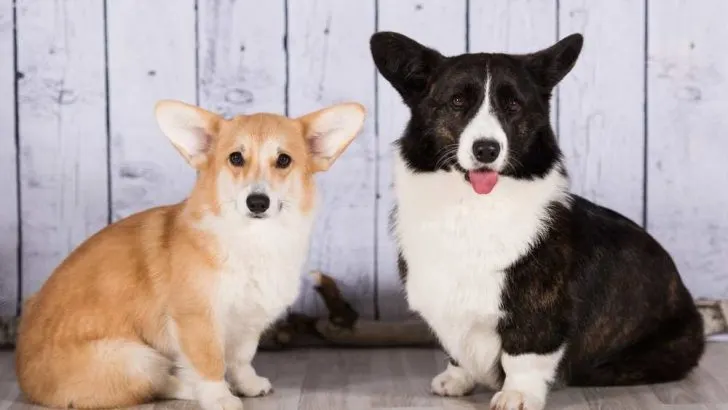All dogs are special, but some are capable of changing your life for the better and inspiring you to become the best version of yourself. We think that Corgis are such dogs.
These small furry short-legged dogs are sure to bring so much positive energy into your life. They are loyal, bright, and loving companions suitable for all dog-lovers, children included.
Corgis are not popular only because the British royal family made them famous. Their popularity has been earned over a long period of time and mostly by their merits.
Even though many people think that Queen Elizabeth II’s Corgi is the very picture of the Corgi breed, it is not entirely true. This royal Corgi is a proud representative of the Pembroke Welsh Corgi type, but there are also Cardigan Welsh Corgis – and they are equally appealing and worthy of your attention.
Although some might confuse these two types of Corgis, there are numerous differences that draw a clear line between these two breeds. We admit that you might notice some similarities at first, look, but if you dig a bit deeper, you are sure to find out Pembroke Corgis and Cardigans do not have that much in common.
Since you are here, we can safely assume that you either already own a Corgi or plan to get one and you want to find out everything you can about this unique dog breed. Perhaps you are indecisive and cannot make up your mind between a Pembroke Welsh Corgi and a Cardigan Welsh Corgi?
Whatever your reasons might be, we are here to help and provide all the information you need. We will deliver the answers to all your questions, even those you do not know you should ask.
Let’s start exploring the world of Corgis together!
The Ultimate Guide: The Cardigan Welsh Corgi vs. The Pembroke Welsh Corgi
No matter what type of Corgi you ultimately choose, it will not make much difference – you will still be getting a fantastic dog and a new loving family member. Nevertheless, we will tell you all there is to know about both types of Corgis.
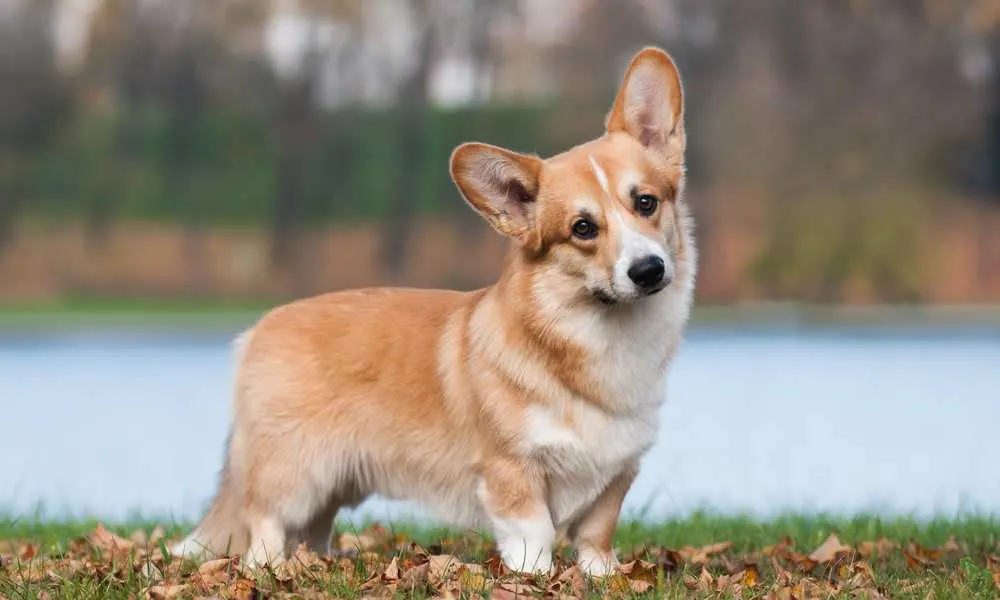
The Pembroke Welsh Corgi
Pembroke Welsh Corgis rank relatively high on all the online dog breed popularity lists. It does not surprise us at all. When it comes to emotions the more you give, the more you get in return and Corgis are very affectionate and loyal dogs. A Queen of England has fallen madly in love with this breed, so why wouldn’t we, the “commoners”?
The history of Pembroke Corgis does begin on the island of Great Britain, but not on the London court. Do you want to find out where these short-legged pups originated from? Stay with us, and you will.
HISTORY
Most dog breeds have traceable breed history, but things are not that simple when it comes to Pembroke Welsh Corgis. As its name suggests, this breed is believed to originate in Wales, but tales, legends, and folklore obscure its actual origins.
Even the name of the breed is a thing of discussion. Some experts claim that the word Corgi is a combination of the Welsh word “cor,” which translates as “to watch over or gather,” and considering the fact that Corgis are indeed small cattle herders and guardians.
Still, there is another theory that ascribes the word corgi to the Celtic language. According to this theory, Corgi is actually a form of the Celtic word for dog. The claims are further supported by the fact that the Norman invaders used to refer to any local dog as a “cur” in the years that followed.
The last theory is quite imaginative and has to do with a legend. Namely, the word “cor” can be interpreted as “dwarf.” When combined with the Welsh form of the word “gi” for a dog, you get “dwarf dog.” The problem is that many interpret it as a “dog of the dwarfs,” too.
You are now probably interested to hear that legend, right? We will not disappoint you; it goes something like this: Two kids were tending their family’s cattle on royal land when they stumbled upon a pair of puppies. First, they thought they found foxes, but when they brought the puppies back home with them they were told that they were a gift from the fairies. Namely, Welsh people believed that the fairies used these tiny dogs to pull their carriages or even rode them during battles. The marks on the puppies’ shoulders were actually imprinted by the fairy saddles. The puppies remained with children, and as they grew they learned to help their human owners watch the cattle. This is how Corgis transformed from magical fairy dogs to become the herding dogs in the centuries to follow and to this very day.
Interesting story, isn’t it? Unfortunately, it is probably only that.
The most plausible theory that has numerous historical findings to support it is far less amusing. The small dog of the British Isles probably came along with the Scandinavian raiders somewhere around the 9th or 10th century. This theory is further reinforced by the fact that the Swedish Vallhund bears many similarities to today’s Pembroke Welsh Corgi. It is believed that the first Corgis came to be when Vallhunds bred with native Welsh dogs. The offsprings most likely expressed excellent cattle herding/driving traits and were thus selectively bred from thereon.
The story does not end there. In the year 1107, Henry I of Britain invited a community of Flemish weavers to come and live in his kingdom. These weavers from Flanders (what we now know as northern Belgium) were among the best ones in the world at that time. Every monarch wanted them to work in their kingdom. A number of these master craftsmen accepted Henry’s invitation and settled in southwestern Wales. They did their best to recreate the agrarian lifestyle in the new homeland, and that meant that they brought their dogs to help them herd cattle and sheep. Many believe that the dogs Flemish weavers brought to Pembrokeshire were also bred with the local herding dogs. For this reason, the Pembroke Welsh Corgi expresses some Spitz characteristics as well.
You can choose to believe any of the theories. The fact remains that the Pembroke Welsh Corgis have an impressive and very long history.
Interesting Fact
Many years ago, both Pembroke and Cardigan Corgis were referred to as “Ci-llathed” or as “Ci Sawdlo”. The first expression translates as “yard-long dog.” Do mind that it is referring to a Welsh yard here. The name “Ci Sawdlo” reveals a little about the nature of Corgis and their habit of nipping at cattle’s heels.

SIZE
Pembroke Welsh Corgis weigh up to 30 pounds but are usually about 22-26 pounds heavy. They are somewhere between 10 and 12 inches tall (at the shoulders).
LIFE EXPECTANCY
The Pembroke Welsh Corgis are small dogs, and as such, they tend to live longer than larger breeds of dogs. On average, a Pembroke Corgi lives about 12 or 13 years. Many reach as much as fifteen or sixteen years of age, but a lot depends on how they spend their life and how well they are cared for.
APPEARANCE
The Pembroke Welsh Corgis have firm, medium-sized, erect ears in proportion to their head’s equilateral triangle. Their ears should be slightly tapered to a rounded point. Their head resembles that of a fox.
The Pembroke Welsh Corgis also have distinct markings on each side of the withers – the already mentioned “fairy saddle.” They shed predominantly during the spring and autumn or annually. The intact females shed during heat too.
If you want to learn more about Corgi shedding and how to deal with it, go here.
Their coat is rather thick and weather-resistant. It can be a combination of the following colors: fawn, black, white, red, sable.
Most Pembroke Welsh Corgis are born with quite a short tail or even no tail at all. If they do get a tail it will most probably be docked when they are 2–5 days in order to conform to the historical tradition or the Breed Standard.
PERSONALITY
Pembroke Welsh Corgis are herding dogs, but nowadays, they are highly-popular family pets as well. They are still used as working dogs throughout England, though.
As family pets, they are sure to brighten up your home with their positive attitude and loving personality. They are happy and intelligent dogs but are also independent and often have a stubborn streak too.
Nevertheless, you should not have a lot of trouble training your Pembroke Corgi as long as you do not expect him or her to be subservient. These dogs think for themselves, and we believe that is a good thing. The good news is that your Pembroke Corgi is a loyal dog that will want to please you.
The easiest way to train a Pembroke Welsh Corgi is to use treats. When it comes to this breed, food is an excellent motivator during training. Be careful, though, not to overdo it; Pembroke Corgis enjoy eating too much and can quickly become overweight if you do not limit their food intake.
If you need a watchdog, you can rely on a Pembroke Corgi as well. Do not let their size and timid look fool you. These small dogs have quite a big bark that will warn you of anything suspicious going on around your house. Pembrokes are often fearless when they sense that something is threatening their family or home.
Pembroke Welsh Corgis need to be socialized at an early age, like most other dog breeds. You should expose your Corgi to other dogs as well as different people, sights & sounds when he or she is very young. In this way, you can rest assured that your pup is going to grow up to become a well-rounded dog.
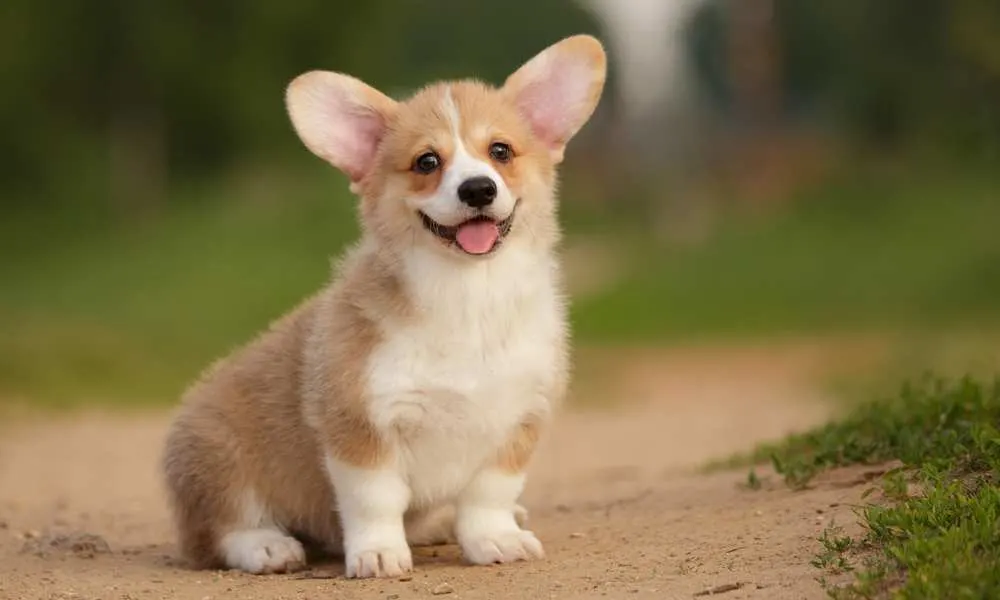
HEALTH
We have good news for all the Pembroke Welsh Corgis – they are generally quite a healthy breed. Unfortunately, this does not mean that they are not prone to some diseases and health conditions – all dog breeds are.
Of course, not all Pembroke Corgis will have any or all of these dire conditions. Your Corgi might be a lucky dog and get to live a happy, long, disease-free life. Still, it is crucial that you are aware of all the health concerns if you’re considering this breed so that you can work on prevention as well.
The first step to avoiding any future health issues is to purchase a healthy puppy from a reputable breeder. A breeder should be able to show you health clearances for both parents of the puppy you plan to buy. Health clearances are valid proof that dogs have been tested for most common health conditions and cleared.
When buying a Pembroke Welsh Corgi, you need to ask for the following health clearances:
- Health clearance from the Orthopedic Foundation for Animals (OFA) for hip and elbow dysplasia (the score should be at least fair or better), hypothyroidism, and von Willebrand’s disease
- Health clearance from Auburn University for thrombophilia
- Health clearance from the Canine Eye Registry Foundation (CERF) which guarantees that your dog’s eyes are normal
The best way to confirm all these health clearances is to check the OFA website (offa.org).
Here is a detailed list of all the health concerns that you, as a Pembroke Corgi owner, should be aware of:
Hip Dysplasia
Hip dysplasia is a hereditary condition that mostly affects large dog breeds. Sadly, Pembroke Welsh Corgis are prone to it as well.
If your dog has inherited this condition, his or her thighbone will not fully develop and will thus not fit snugly into the hip joint. The best method to diagnose the problem is to perform an X-ray. You can also observe your dog for signs of pain and lameness on one or both rear legs, but do know that sometimes dogs do not exhibit any signs of discomfort, especially when young.
As dog ages, the chances that arthritis will develop increase. If you have a dog with hip dysplasia, you should not breed him or her. Likewise, make sure you check if the dog you are planning to buy is cleared of it. The breeder must offer you proof that both parents have been tested for hip dysplasia and were cleared too.
Cataracts
A cataract is a condition that usually affects dogs in old age. It causes opacity on the eye’s lens, and as a result, your dog will have poor vision. When you look into your dog’s eye(s), you will notice that they look cloudy. The good news is that cataracts can usually be surgically removed to improve your Corgi’s vision.
Cutaneous Asthenia
Cutaneous Asthenia is a condition which is known as Ehlers-Danlos syndrome or dermatosparaxis too. Sometimes it is also called dominant collagen dysplasia. No matter how you name it, it is more important to know how it can affect your Corgi pet.
Cutaneous Asthenia causes the defective connective tissue located in your dog’s skin to become fragile and loose. It affects the blood vessels too, and thus leads to excessive bruising and blood blisters.
Cystinuria
Cystinuria is a condition characterized by the high levels of a protein named cystine. The cystine gets into the dog’s urine and can lead to stone formation. Typically this can cause a significant problem and require vet intervention only in males.
Degenerative Myelopathy (DM)
DM is a progressive disease that occurs as a result of the degeneration of the nervous tissue of the spinal cord located in the lower back area. Many vets misdiagnose this condition as disk disease due to similar symptoms such as rear leg lameness and weakness that, sadly, end up with paralysis.
Epilepsy
Epilepsy is a neurological condition that is most usually inherited. Dogs that suffer from this condition can have either mild or severe seizures and thus exhibit unusual behavior such as:
- Frantic running as if being chased
- Staggering
- Hiding
- Falling down with rigid limbs
- Losing consciousness
The seizures are far from being pleasant to watch, especially by the loving owner. Still, the long-term prognosis for Corgis who suffer from this disease is generally very good. It is highly important to take your four-legged pet to the vet as soon as you notice the seizures or any unusual behavior we have listed. The sooner your dog is properly diagnosed, the sooner will he or she get the appropriate treatment and feel better.
Intervertebral Disk Disease
Having such a long back is what makes the Pembroke Welsh Corgis so cute, but sadly it makes them prone to the rupture in a spinal disk as well. The symptoms you should pay close attention to are the following ones:
- Unsteadiness
- Problems with going up or down the stairs
- Problems with getting on and off the furniture furniture
- Knuckling over of limbs
- Weakness
- Paralysis
If you notice any of these symptoms, go to a vet as soon as possible.
Patent Ductus Arteriosus (PDA) with Pulmonary Hypertension
Patent Ductus Arteriosus is a congenital defect of the vascular system that can be diagnosed early on during your puppy’s regular veterinary examination. This defect enables unoxygenated blood to bypass the lungs and can lead to pulmonary hypertension. Luckily, high blood pressure within the lungs is a rare complication of the PDA disease. The most important thing is to get the proper diagnosis as soon as possible since this condition; sadly surgically corrected.
Progressive Retinal Atrophy (PRA)
PRA is an eye disease that leads to the gradual deterioration of the retina. At first, dogs who suffer from this condition lose sight during the night and thus become night-blind. Over time, the illness progresses, and dogs lose sight during the day too. On the bright side, Corgis are highly adaptive, just like most animals, and can cope with their limited or lost vision quite well. It would be best to try not to make any changes to their surroundings, though.
Retinal Dysplasia
Retinal Dysplasia, as you can assume, is yet another eye-related disease. It is characterized by the abnormal development of the retina. In some cases, the retina can even detach and cause blindness.
Von Willebrand’s Disease
Von Willebrand’s disease is not reserved only for humans, sadly your dog can suffer from it as well. It is a blood disorder that prevents normal blood clotting. As a result, the affected Corgi can have some of the following symptoms:
- Nosebleeds
- Bleeding gums
- Prolonged bleeding from cuts or surgery incisions
- Prolonged bleeding during heat cycles
- Prolonged bleeding after whelping
- Blood in the stool
Your vet can diagnose this disorder usually somewhere between three and five years of age. Even though your Corgi cannot be cured entirely, there are treatments that can keep this condition under control and allow your pup to lead a more-less normal life. These treatments include:
- Cauterizing or suturing injuries
- Transfusions before surgery
- Avoidance of specific medications.
It is crucial to test your dog for this condition prior to any surgical intervention, or you risk his or her life.
CARE
Being herding dogs, Pembroke Welsh Corgis are very athletic and fast. You have to make sure they have plenty of exercise every single day, especially if they are apartment dogs. Pembrokes were bred to be herding dogs and require plenty of exercises each day. Physical stimulation is crucial in preventing obesity, as well.
Since Pembroke Corgis have such short legs, you must not expect them to be able to hop on or down from any tall furniture. Even the couch can prove to be dangerous for them since fractures are a common issue when it comes to this breed.
Their diet should be protein-based, and you should avoid treats as much as possible. It would be best to give your corgi two small meals rather than one big meal since that can help speed up his or her metabolism and prevent weight gain.
It does not really matter where you live since Pembroke Welsh Corgis can adapt to living in both the country and the city. The climate should not be an issue either, since their coats are weather-resistant. The only thing they cannot do without is human-contact as they are people-oriented dogs. This means that Corgis need to be a part of their family at all times – you should not leave them alone for too long.
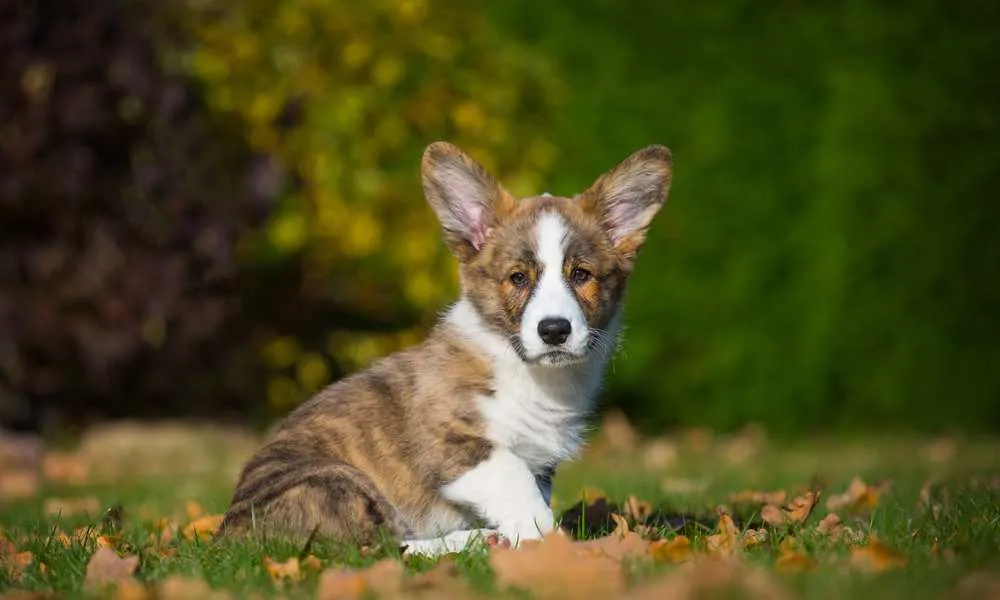
The Cardigan Welsh Corgi
HISTORY
The Cardigan Welsh Corgi is one of the oldest breeds of dogs in the British Isles. Namely, Cardigans have been around in Wales for more than 3,000 years. This breed is believed to descend from the Teckel family of dogs and is thus related to the Dachshund breed too.
There are no fairy tales or legends to enjoy here since it is generally agreed that the first Cardigan Welsh Corgis were brought in aboriginal form by the Celtic tribes during their migration from central Europe to Wales. The first Corgis were most likely a result of breeding between the members of the Teckel and the Spitz families.
The original role of a Cardigan Corgi was to go in front of the herd or cattle and chase off any potential predator. In time, Cardigans started acting as true herders driving the cattle from the Welsh farms to numerous markets across the country. Probably, somewhere around this time, the Cardigans got crossed with local sheepdogs in order to create a more versatile working dog. From there on, people started adopting the faithful cardigan as their family dogs and used them as guardians, herding dogs, and vermin exterminators.
Some of the Corgis were affected by the Viking invasion that occurred about 1,000 years ago. Some were changed when Flemish weavers arrived in Wales. The latter were bred with a Spitz-type of dog to produce what we now know as the Pembroke Welsh Corgi. Still, some Corgis lived in areas untouched by all these influences and thus retained their original blood – those are the descendants of the Cardigan Welsh Corgis as we know them today.
When the first dog shows began in the late 1800s, Corgis were not the public’s favorites. It was not until the 1920’s that the term “Corgi” was widely used and the breed history documented.
In 1925, the Corgi breed was exhibited under the Great Britain Kennel Club jurisdiction, but no distinction was made between the Pembroke and Cardigan Welsh Corgis. These two breeds were thus registered as a single one. Unfortunately, as a consequence, these two breeds were crossed. Some judges preferred the traits of Cardigan Corgis, while others fancied Pembroke Corgis more. The owners were unsatisfied with such treatment of their dogs and raised their voices so, in 1934, the Kennel Club finally corrected the error and separated these two breeds.
It was in June of 1932 that the first pair of the Cardigan Welsh Corgis was imported into the USA. These days, the Cardigan Welsh Corgi Club of America, Inc. has numerous members and holds a popular annual contest for champions.
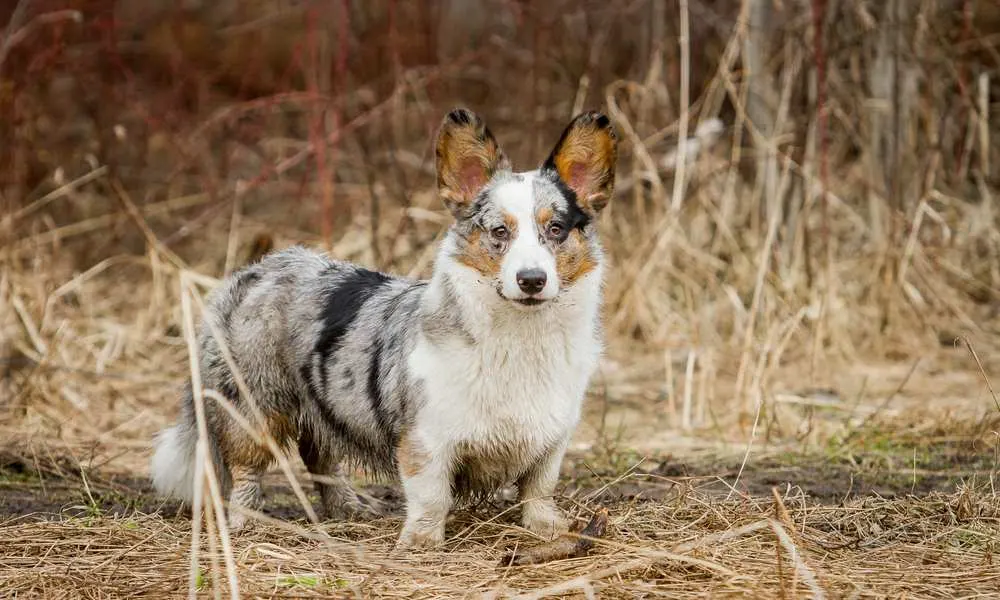
SIZE
The tiny Cardigan Welsh Corgis do not differ much from their Pembroke relatives in terms of size, even though they are slightly bigger. They are somewhere between 10.5 and 12.5 inches tall. The males weigh more than females – from 30 to 38 pounds on average. Females weigh from 25 to 34 pounds.
LIFE EXPECTANCY
Cardigan Welsh Corgis are small dogs and are thus expected to live quite long, just as their Pembroke relatives. They typically live somewhere around 12 to 15 years. If you are fortunate, your Cardigan can live up to 18 years, as that is the maximum age for this breed. This does not happen too often, regretfully.
If you want to learn more about your Corgi-s lifespan, go here.
APPEARANCE
Even though Cardigan and Pembroke Corgis look alike, they are distinct breeds with differences that cannot be overlooked. Cardigan Welsh Corgis, for example, have a tail of standard length, while Pembrokes are, as we have already mentioned, often born without a tail.
Cardigan Welsh Corgis have a thick weatherproof coat as well. Unlike Pembroke Corgis, which come in limited colors, Cardigans are more diverse. They can come in all shades of red, brindle, sable, brindle, or be black with or without tan points.
One unusual color is quite specific for this particular breed and is often used to distinguish it from the Pembroke Welsh Corgi breed. It is a blue merle. Only Cardigans come in this shade combined with black and gray color. They can be marbled and have tan or brindle points.
Cardigans often have flashes of white color around their neck, often as a collar. Often white can be seen on their chest, legs, underpants, and muzzle. The tip of their tail is often white too. There should not be too much white on their head, though, especially not around the eyes. Predominantly white Cardigan Welsh Corgis are often disqualified at the dog exhibits.
The Cardigans have blue eyes and black noses; only blue merles sometimes feature a butterfly nose.
PERSONALITY
Being so similar in appearance, Cardigan and Pembroke Welsh Corgis cannot but be as similar in their temperament too. Cardigan Corgis are as faithful and lovable dogs as their relatives, which makes them suitable for family pets, even in families with small children. When socialized early on, Cardigans enjoy spending time with children and playing with them. They can befriend other pets too, so there is no need for you to limit yourself in that regard – you can have another dog or a cat if you want to!
Cardis, as many refer to dogs of this breed, are trained easily, especially if you start at an early age. They can be loyal and vigilant guardians since their “big dog” bark is likely to scare off any intruder.
Their herding nature makes them especially fond of the outdoors. They are athletic, rugged herders, and even though they can spend hours lying around your home, they need physical activity and mental stimulation in order to thrive.
Cardigans have a stubborn streak, just like Pembrokes. It should not be much of an issue though, especially if you show them you are the boss early on.
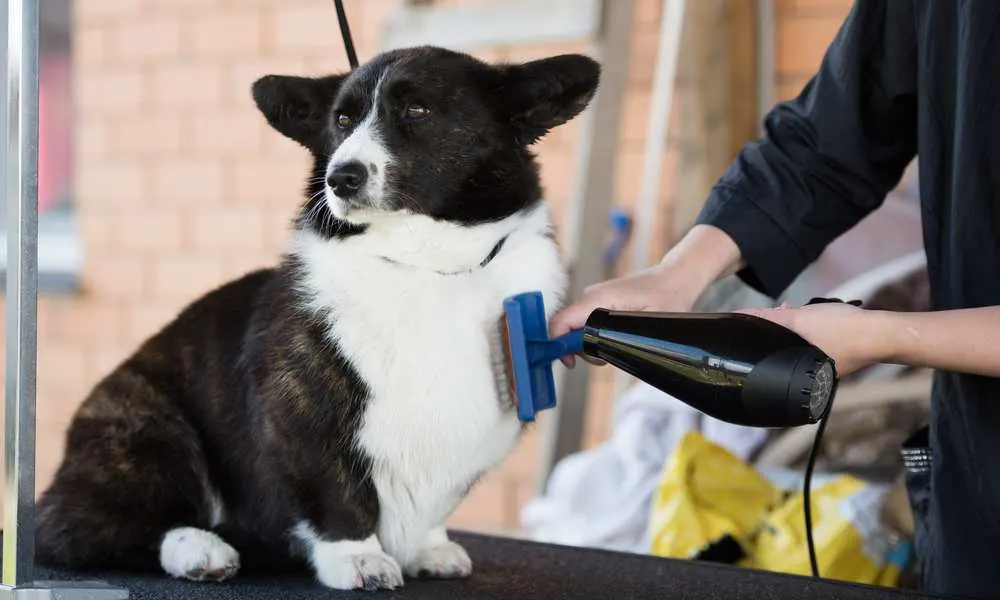
HEALTH
The Cardigan Welsh Corgi breed is not prone to many diseases. Unfortunately, even the healthiest breeds out there are bound to be affected by some health conditions. Being close blood relatives both Cardigan Welsh Corgis and Pembroke Welsh Corgis have the same health concerns. It does not even matter if your dog is purebred or crossbred. For this reason, we will not repeat ourselves but rather only list the most diseases that concern Corgi owners in general:
- Hip dysplasia
- Progressive retinal atrophy (PRA) which can lead to blindness
- Degenerative myelopathy
You should also remember that you should be a responsible owner (especially if you want to breed your Cardigan Corgi) and perform the following tests:
- OFA or PennHip test for hip dysplasia,
- Genetic test to detect a PRA carrier
- The genetic test that identifies the puppies that are at an increased risk of developing degenerative myelopathy
When buying a puppy, the breeder should also provide you with all the relevant test results. If he or she cannot do that, you can rely on the list of all the dogs that have been tested for PRA or cleared of it by their pedigree.
CARE
Cardigan Welsh Corgis are even-tempered dogs that can thrive in almost any environment. Still, they are prone to boredom as well as separation anxiety, and you must not neglect them or leave them unattended for too long.
You also need to exhibit strong leadership from day one, or you can end up with quite a stubborn dog with a will of its own. If you fail to socialize your pup correctly, it can grow to become a bit standoffish towards people and other animals.
Just like Pembrokes, the Cardigans require a lot of activity and mental stimulation. They enjoy herding and spending high-quality time with their family.
The tendency to herd makes them great with small children.
Mostly, you need to rely on your common sense to keep your Cardigan Welsh Corgi happy and healthy. Watch his or her diet, secure plenty of exercises, and outdoor time. Make sure your dog feeds well. Do not overdo it, though, or you can end up with a chubby dog rather quickly. Corgis are highly prone to becoming overweight. We cannot overemphasize how vital the proper diet and exercise routine are.
Your Cardigan Welsh Corgi has a thick coat that needs to be brushed regularly. You should also brush his or her teeth every day or at least twice a week. Clean your Corgi’s ears weekly too.
Follow up on all the required examinations and do not miss any vaccines. Call your vet or a pet emergency hospital whenever you notice something seems unusual. Test your pup for diseases and conditions that are common in Corgis.
It would also be wise to sign up for pet health insurance. It will help you finance all the necessary medical tests and procedures throughout your Corgi’s life.
A pet is much like a toddler – you need to supervise them both at all times. Do not allow for your Corgi to feel bored – that is when the naughty stuff starts.

The Difference Between The Pembroke Welsh Corgi and The Cardigan Welsh Corgi Breed: Short Overview
Now that you know almost everything there is to know about both the Pembroke and the Cardigan Welsh Corgi breed, you are more than capable of distinguishing these two breeds. We will still try to make things even easier for you by providing you with a short overview of all the differences that make the difference.
Do not beat yourself down if you used to mix these two types of Corgis before. In case you forgot, even the U.K. The Kennel club registered them as one breed at first.
Both the Pembroke and the Cardigan Corgis have similar heads and bodies. They have almost identical personalities as well. Both breeds are highly intelligent and have a superb herding ability.
So, what are the differences? Do you remember? If not, check out the following list:
- The Cardigan Corgis are slightly larger and heavier boned than the Pembroke Corgis. They can weigh up to 38 pounds (males), while Pembrokes rarely weigh over 32-33 pounds.
- The Pembroke Welsh Corgis have docked tails (if any), while Cardigans have long tails with white tips. This is one of the easiest ways to determine whether your Corgi is A member of the Cardigan breed or the Pembroke one.
- Pembroke Welsh Corgis have a thick coat that can be red, sable, or fawn. There are also tri-colored Pens (red, black, and tan). Their head is shaped like the head of a fox. Cardigan Welsh Corgis can be blue merle too. They often have tan spots too.
- Cardigan Welsh Corgis have predominantly round blue eyes, while Pembrokes have dark oval-shaped eyes.
- Pems have somewhat erected ears, too, while Cardigans have slightly larger ears.
- Pembroke Welsh Corgis are a bit shorter in length and have slightly straighter legs than Cardigan Welsh Corgis.
Learn More: What To Know About Corgis Before Getting One?
Final Words
There are numerous similarities between the Pembroke Welsh Corgis and the Cardigan Welsh Corgis, but they are definitely two different breeds. Some differences simply cannot be overlooked.
Still, no matter what type of Corgi you choose to befriend, you will not regret the decision. Both Pembrokes and Cardigans make excellent family dogs, herders, and guardians. Your Corgi will be a loyal and affectionate member of your family; we are positive.

